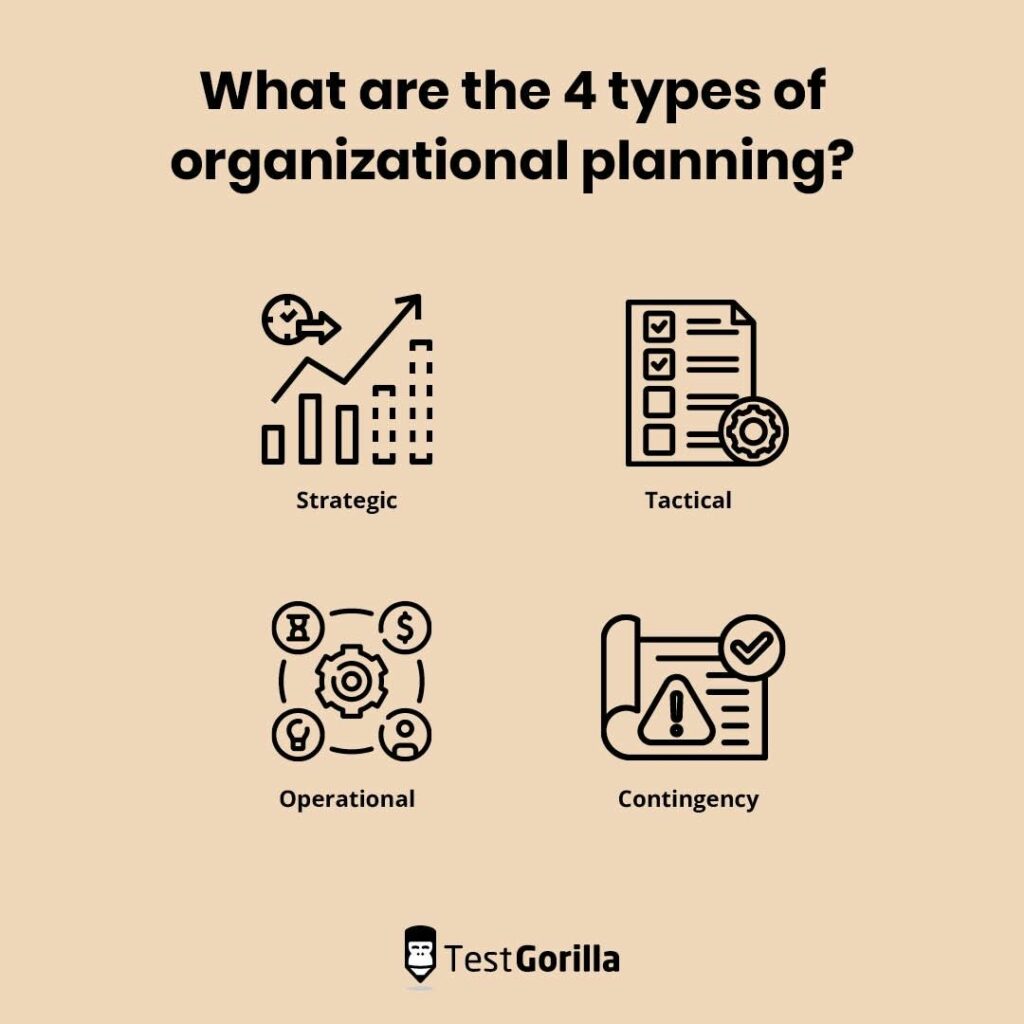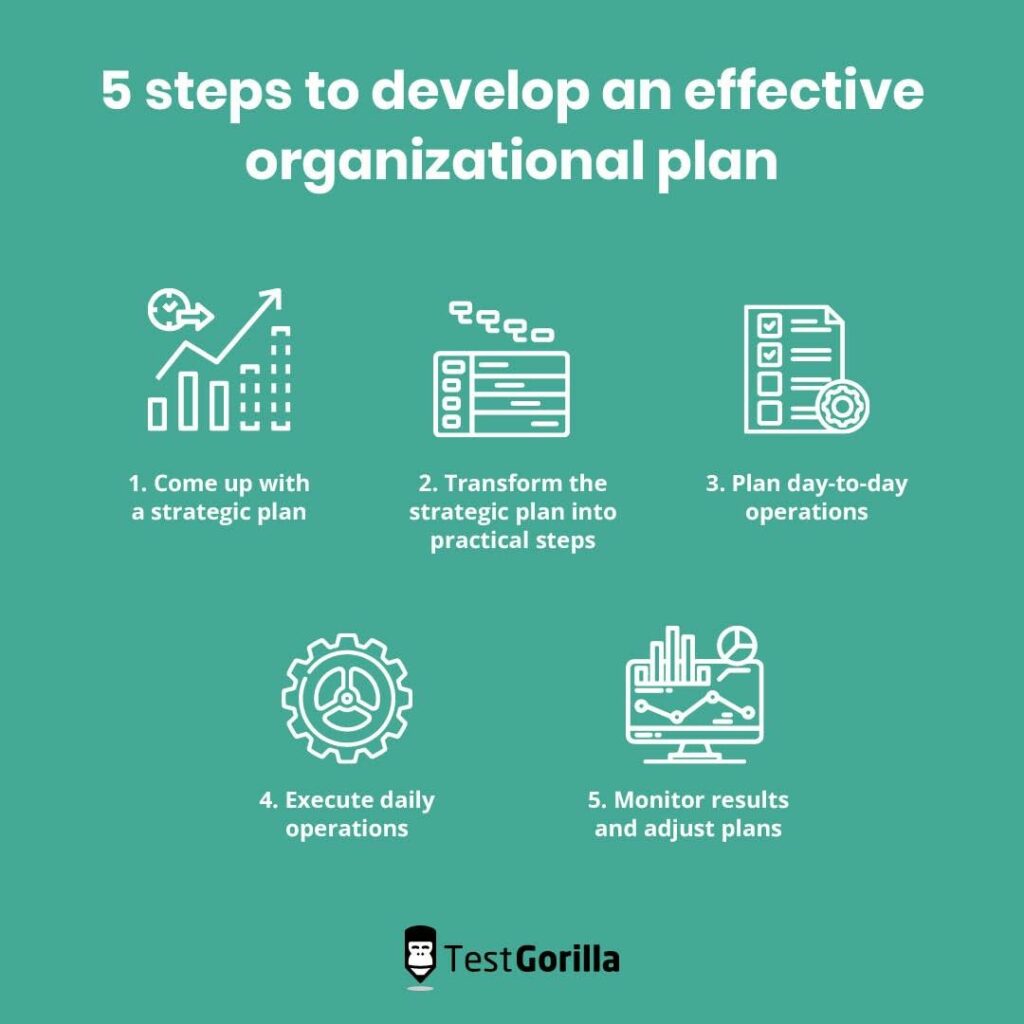If you want to start or grow your business – or make it more profitable – you need an organization plan. It’s no secret that the most successful companies have the best organizational goals and the right strategies for attracting top talent to achieve their objectives.
Planning plays a vital role in any business organization. As such, the right organizational plan will help make your business a titan in its industry, whereas a poor one will allow your competitors to pull ahead of your company.
Read on to discover creative ways an organizational plan will bring value to your business and can improve your revenue.
Table of contents
What is an organizational plan?
An organizational plan is how businesses prepare their affairs to achieve success in their industry. It may include daily business operations, organizational goals, and potential expenses.
An organizational plan usually begins with big, long-term objectives but is then broken down into smaller, attainable goals. This makes it easier for your organization to define success, plan ahead, and achieve its goals.
Why is an organizational plan important?
Organizational plans are crucial for businesses because they enable you to create an effective, realizable method to achieve your business goals.
A solid organizational plan will therefore improve your company’s performance. Research shows that businesses with good plans are 16% more likely to succeed.
Organizational plans may also clarify the roles, expectations, and responsibilities of employees in your organization. And they are a great way to highlight the areas in which your business has shortcomings or issues.
What are the 4 types of organizational planning?
Effective planning relies on a firm understanding of the four types of organizational planning. Knowing which organizational plan to apply to your business is crucial to steer your company toward a profitable and prosperous future.
1. Strategic planning
A strategic plan involves the creation of broad, long-term goals for your company. Senior management will usually oversee these kinds of plans; however, smaller companies tend to involve other employees.
Typically, strategic planning considers controllable and non-controllable variables and how to adjust them. The objectives must align with your company’s general mission, vision, and values.
2. Tactical planning
These shorter-term goals show how your company plans to achieve its longer-term strategic plan. Tactical plans typically take a year to complete, with middle managers establishing these goals and overseeing the actions.
3. Operational planning
Operational plans include department-specific objectives and targets and are focused on executing the tactical plan. Thus, for example, your company should have a working plan for the finance, marketing, and IT departments.
4. Contingency planning
Usually, contingency planning is associated with risk management, because a good contingency plan will address both known and unknown risks. Such planning enables your company to prepare for unforeseen circumstances that could harm your business.
What are some examples of organizational planning?
Below are examples of organizational planning to help you understand the various forms a plan can take. With this knowledge, you can decide which kind of organizational plan suits your company.
1. Workforce development planning
Industry-leading companies do not become successful by chance. Instead, they earn their success through years of practical workforce training. Workforce development planning entails training your employees to increase their productivity and output.
By investing in your employees, you’ll create a loyal, diverse, and satisfied workforce focused on achieving your business’s ambitious goals.
2. Product and services planning
Product and service planning aims to make your organization’s products or services more appealing to its target market. This involves strategically creating schemes that set your business apart from competitors.
Being in a highly competitive industry can be difficult. That’s why the operations, finance, and marketing departments are tasked with developing innovative ways to keep your business ahead in its industry.
3. Expansion plans
A good business is always focused on growth. Hence, expansion plans identify growth opportunities and roadblocks your organization might face in its industry, helping you develop strategies to take advantage of those opportunities and overcome the obstacles.
4. Financial planning
Making plans to manage debt and utilize profits is one of the best ways to ensure your business is sustainable. Financial analysts are in charge of this, so they will analyze financial performance and give recommendations to help your business make better decisions.
Financial planning ensures you optimize every fund flow in and out of your business. You’ll also require employees with the right budget-management skills to draft the perfect plan.
5 steps to develop an effective organizational plan
1. Come up with a strategic plan
Identifying your company’s objectives will help you create more concrete strategic plans. But to identify these goals, you’ll need adequate data about your company.
Good data will guide you in making strategic decisions based on previous performance and other indicators, ensuring you can pave a clear path toward your goals.
2. Transform the strategic plan into practical steps
Establishing practical steps for achieving your strategic goals is the focus at this stage. A good example is requesting quarterly reports to ensure that the IT department is hitting its quota.
It also involves implementing every action that contributes to hitting your targets, from sourcing raw materials to manufacturing the final product.
3. Plan day-to-day operations
This stage focuses on individual employee performance. Managers set goals and targets to ensure employees convert their work hours into profit for your business and more effective functioning of your teams. HR, for example, can be tasked with ensuring that unconscious bias does not exist in the workplace.
Similarly, the quality assurance team can create schedules to inspect raw materials before manufacturing begins.
4. Execute daily operations
At this stage, you should execute the theoretical strategies you set for daily operations. This requires applying all the planning from the previous steps to enable your organization to reach its strategic goals.
You can check these daily targets on your vision board as you progress, gradually allowing your longer-term objectives to materialize.
5. Monitor results and adjust plans
A plan is more likely to fail if you don’t monitor any progressive performance. To verify that your plan is complete, you should make provisions for adjusting and monitoring results to ensure they align with the goals you set.
Doing this will help your organization identify areas where your company didn’t meet its goals and inform you of any necessary changes. By extension, you should have the information required for performance management.
Strengthen your recruitment process with TestGorilla
Although organizational planning might be a long and complex process, it is vital for your company’s success. Why? The right strategy will ensure your employees are clear on your organization’s vision and the actions required to achieve these goals.
A well-defined organizational plan will positively impact your workforce, since all employees will understand their day-to-day tasks and why they are needed. They’ll have explicit objectives to ensure they remain productive and focused.
TestGorilla facilitates your recruitment of skilled professionals who can help you develop a stellar organizational plan. Moreover, it helps you minimize any chance of unconscious bias creeping into your recruitment, helping you employ the best.
Create a free account with TestGorilla today to begin hiring.
Related posts
Hire the best candidates with TestGorilla
Create pre-employment assessments in minutes to screen candidates, save time, and hire the best talent.
Latest posts
The best advice in pre-employment testing, in your inbox.
No spam. Unsubscribe at any time.

Hire the best. No bias. No stress.
Our screening tests identify the best candidates and make your hiring decisions faster, easier, and bias-free.
Free resources
This checklist covers key features you should look for when choosing a skills testing platform
This resource will help you develop an onboarding checklist for new hires.
How to assess your candidates' attention to detail.
Learn how to get human resources certified through HRCI or SHRM.
Learn how you can improve the level of talent at your company.
Learn how CapitalT reduced hiring bias with online skills assessments.
Learn how to make the resume process more efficient and more effective.
Improve your hiring strategy with these 7 critical recruitment metrics.
Learn how Sukhi decreased time spent reviewing resumes by 83%!
Hire more efficiently with these hacks that 99% of recruiters aren't using.
Make a business case for diversity and inclusion initiatives with this data.



















